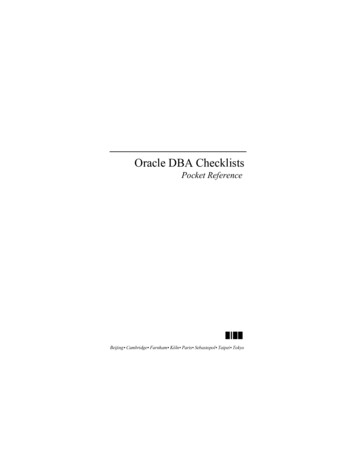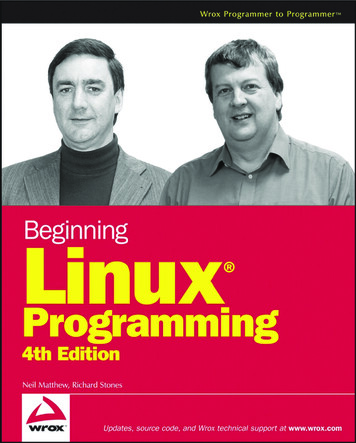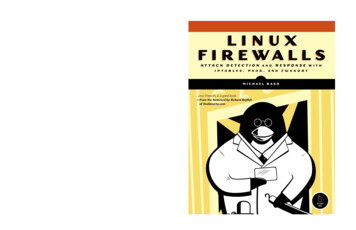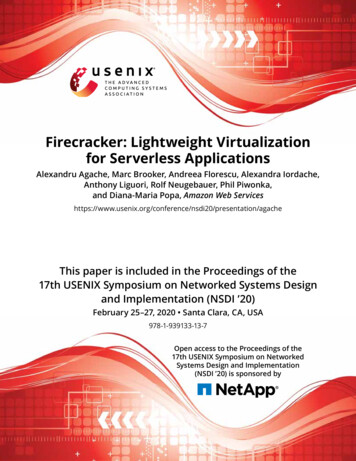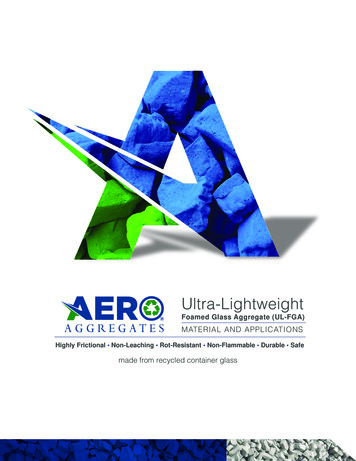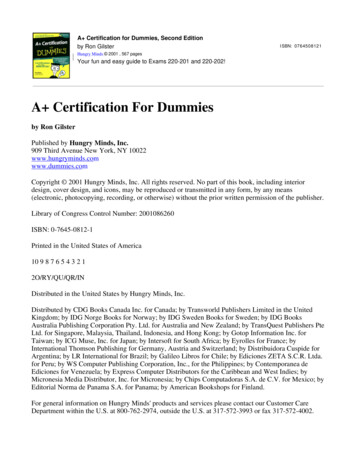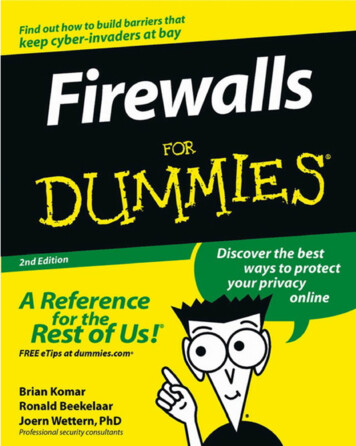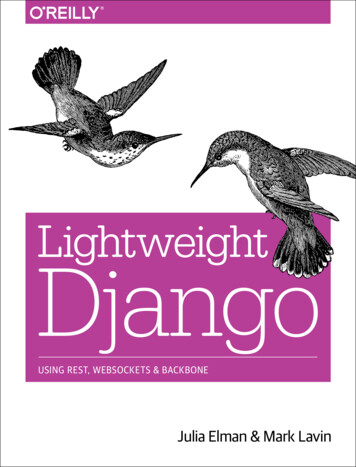
Transcription
LightweightDjangoUSING REST, WEBSOCKETS & BACKBONEJulia Elman & Mark Lavin
Lightweight DjangoLearn how to make the most of Django’s decoupled design by choosingthe components you need to build the lightweight applications you want.Once you finish this book, you’ll know how to build single-page applicationsthat respond to interactions in real time. If you’re familiar with Python andJavaScript, you’re good to go. Learn a lightweight approach for starting a new Django project Break reusable applications into smaller services thatcommunicate with one another Create a static, rapid prototyping site as a scaffold for websitesand applications Build a REST API with django-rest-framework Learn how to use Django with the Backbone.js MVC framework Create a single-page web application on top of your REST API Integrate real-time features with WebSockets and the Tornadonetworking library Use the book’s code-driven examples in your own projectsgreat resource for“Agoingbeyond traditionalapps and learning howDjango can power thebackend of single-pageweb applications.”—Aymeric AugustinDjango core developer, CTO, oscaro.coma good idea—I think“Suchthis will lower the barrierof entry for developerseven more the moreI read, the more excitedI am!”—Barbara ShaurettePython Developer, Cox Media GroupMark Lavin is Technical Director at Caktus Consulting Group in Durham, NorthCarolina. He came to Python web development after years of pricing derivativeson Wall Street. Mark maintains several open source projects related to Djangodevelopment.US 39.99Twitter: @oreillymediafacebook.com/oreillyElman & LavinJulia Elman, a frontend developer and tech education advocate, started learningDjango in 2008 while working at World Online. She is one of the co-founders forGirl Develop It RDU and PyLadies RDU, organizations that have helped over 850women learn to program.PY THON/ WEB DEVELOPMENTLightweight DjangoHow can you take advantage of the Django framework to integrate complexclient-side interactions and real-time features into your web applications?Through a series of rapid application development projects, this hands-onbook shows experienced Django developers how to include REST APIs,WebSockets, and client-side MVC frameworks such as Backbone.js intonew or existing projects.LightweightDjangoUSING REST, WEBSOCKETS & BACKBONECAN 41.99ISBN: 978-1-491-94594-0Julia Elman & Mark Lavin
Lightweight DjangoJulia Elman and Mark Lavin
Lightweight Djangoby Julia Elman and Mark LavinCopyright 2015 Julia Elman and Mark Lavin. All rights reserved.Printed in the United States of America.Published by O’Reilly Media, Inc., 1005 Gravenstein Highway North, Sebastopol, CA 95472.O’Reilly books may be purchased for educational, business, or sales promotional use. Online editions arealso available for most titles (http://safaribooksonline.com). For more information, contact our corporate/institutional sales department: 800-998-9938 or corporate@oreilly.com.Editor: Meghan BlanchetteProduction Editor: Colleen LobnerCopyeditor: Rachel MonaghanProofreader: Sonia SarubaNovember 2014:Indexer: Wendy CatalanoCover Designer: Ellie VolckhausenInterior Designer: David FutatoIllustrator: Rebecca DemarestFirst EditionRevision History for the First Edition:2014-10-24: First releaseSee http://oreilly.com/catalog/errata.csp?isbn 9781491945940 for release details.The O’Reilly logo is a registered trademark of O’Reilly Media, Inc. Lightweight Django, the cover image, andrelated trade dress are trademarks of O’Reilly Media, Inc.Many of the designations used by manufacturers and sellers to distinguish their products are claimed astrademarks. Where those designations appear in this book, and O’Reilly Media, Inc. was aware of a trademarkclaim, the designations have been printed in caps or initial caps.While the publisher and the authors have used good faith efforts to ensure that the information and in‐structions contained in this work are accurate, the publisher and the authors disclaim all responsibility forerrors or omissions, including without limitation responsibility for damages resulting from the use of orreliance on this work. Use of the information and instructions contained in this work is at your own risk. Ifany code samples or other technology this work contains or describes is subject to open source licenses orthe intellectual property rights of others, it is your responsibility to ensure that your use thereof complieswith such licenses and/or rights.ISBN: 978-1-491-94594-0LSI
Table of ContentsPreface. . . . . . . . . . . . . . . . . . . . . . . . . . . . . . . . . . . . . . . . . . . . . . . . . . . . . . . . . . . . . . . . . . . . . . . viiPrerequisites. . . . . . . . . . . . . . . . . . . . . . . . . . . . . . . . . . . . . . . . . . . . . . . . . . . . . . . . . . . . . . . . . xiii1. The World’s Smallest Django Project. . . . . . . . . . . . . . . . . . . . . . . . . . . . . . . . . . . . . . . . . . . . 1Hello DjangoCreating the ViewThe URL PatternsThe SettingsRunning the ExampleImprovementsWSGI ApplicationAdditional ConfigurationReusable Template12234567102. Stateless Web Application. . . . . . . . . . . . . . . . . . . . . . . . . . . . . . . . . . . . . . . . . . . . . . . . . . . 13Why Stateless?Reusable Apps Versus Composable ServicesPlaceholder Image ServerViewsURL PatternsPlaceholder ViewImage ManipulationAdding CachingCreating the Home Page ViewAdding Static and Template SettingsHome Page Template and CSSCompleted Project131414161617182023232426iii
3. Building a Static Site Generator. . . . . . . . . . . . . . . . . . . . . . . . . . . . . . . . . . . . . . . . . . . . . . . 31Creating Static Sites with DjangoWhat Is Rapid Prototyping?Initial Project LayoutFile/Folder ScaffoldingBasic SettingsPage RenderingCreating Our Base TemplatesStatic Page GeneratorBasic StylingPrototype Layouts and NavigationGenerating Static ContentSettings ConfigurationCustom Management CommandBuilding a Single PageServing and Compressing Static FilesHashing Our CSS and JavaScript FilesCompressing Our Static FilesGenerating Dynamic ContentUpdating Our TemplatesAdding Metadata31323232333535363941464647495050515454564. Building a REST API. . . . . . . . . . . . . . . . . . . . . . . . . . . . . . . . . . . . . . . . . . . . . . . . . . . . . . . . . 61Django and RESTScrum Board Data MapInitial Project LayoutProject SettingsNo Django Admin?ModelsDesigning the APISprint EndpointsTask and User EndpointsConnecting to the RouterLinking ResourcesTesting Out the APIUsing the Browsable APIAdding FilteringAdding ValidationsUsing a Python ClientNext Stepsiv Table of Contents6162636466666969717474777781868991
5. Client-Side Django with Backbone.js. . . . . . . . . . . . . . . . . . . . . . . . . . . . . . . . . . . . . . . . . . 93Brief Overview of BackboneSetting Up Your Project FilesJavaScript DependenciesOrganization of Your Backbone Application FilesConnecting Backbone to DjangoClient-Side Backbone RoutingCreating a Basic Home Page ViewSetting Up a Minimal RouterUsing .template from Underscore.jsBuilding User AuthenticationCreating a Session ModelCreating a Login ViewGeneric Form ViewAuthenticating RoutesCreating a Header View949596981001021021031041071071111171201216. Single-Page Web Application. . . . . . . . . . . . . . . . . . . . . . . . . . . . . . . . . . . . . . . . . . . . . . . 131What Are Single-Page Web Applications?Discovering the APIFetching the APIModel CustomizationsCollection CustomizationsBuilding Our Home PageDisplaying the Current SprintsCreating New SprintsSprint Detail PageRendering the SprintRouting the Sprint DetailUsing the Client StateRendering the TasksAddTaskViewCRUD TasksRendering Tasks Within a SprintUpdating TasksInline Edit 1561561601637. Real-Time Django. . . . . . . . . . . . . . . . . . . . . . . . . . . . . . . . . . . . . . . . . . . . . . . . . . . . . . . . . 167HTML5 Real-Time APIsWebsocketsServer-Sent EventsWebRTC167168168169Table of Contents v
Websockets with TornadoIntroduction to TornadoMessage SubscriptionsClient CommunicationMinimal ExampleSocket WrapperClient ConnectionSending Events from the ClientHandling Events from the ClientUpdating Task State1691701751781791821851871931958. Communication Between Django and Tornado. . . . . . . . . . . . . . . . . . . . . . . . . . . . . . . . . 199Receiving Updates in TornadoSending Updates from DjangoHandling Updates on the ClientServer ImprovementsRobust SubscriptionsWebsocket AuthenticationBetter UpdatesSecure UpdatesFinal Websocket Server199201203204204208212214217Index. . . . . . . . . . . . . . . . . . . . . . . . . . . . . . . . . . . . . . . . . . . . . . . . . . . . . . . . . . . . . . . . . . . . . . . 223vi Table of Contents
PrefaceSince the creation of Django, a plethora of web frameworks have been created in variousopen source communities. Frontend-focused web frameworks such as Angular.js, Em‐ber.js, and Backbone.js have come out of the JavaScript community and become fore‐runners in modern web development. Where does Django fit into all of this? How canwe integrate these client-side MVC frameworks into our current Django infrastructure?Lightweight Django teaches you how to take advantage of Django’s Pythonic “batteriesincluded” philosophy. Its aim is to guide you through misconceptions that Django istoo “heavy” for rapid application development. From creating the world’s smallestDjango application to building a RESTful API, Lightweight Django will walk you throughhow to take advantage of this popular Python web framework.Why This Book?We wanted to write this book primarily because we love Django. The community isamazing, and there are so many resources to learn about Django and to develop appli‐cations using it. However, we also felt like many of these resources, including the officialDjango documentation, put too much emphasis on the power of Django and not on itsdecoupled design. Django is a well-written framework, with numerous utilities forbuilding web applications included. What we want this book to highlight is how youcan break apart and potentially replace these components to pick and choose what bestsuits the application you want to build. Similarly, we wanted to break down the typicalstructure of Django projects and applications. Our goal is to get you to stop asking “howdo I do X in Django?” and instead ask “does Django provide anything to help me do X,and if not, is something available in the community?”In addition, we wanted to answer questions about where Django fits in a Web in whichmore applications are built with heavy client-side interactions and real-time compo‐nents, and paired with native mobile applications. As a framework, Django is agnosticabout the client, which leaves some users feeling like Django doesn’t have an answer forvii
building these types of applications. We hope that this book can help shape how thecommunity approaches these types of problems. We want to see Django and its com‐munity continue to grow, and we want to be a part of it for many more years to come.Who Should Read This Book?If you are interested in reading this book, you are most likely an intermediate Djangouser. You’ve gone through the Django polls tutorial, as well as written a few basicDjango web applications, and are now wondering what the next steps are. LightweightDjango serves as that next step to help outline how to utilize Django’s utilities andsimplicity.Or you might be currently working on a Django project and wondering how to integratesomething like Backbone.js into your project. Lightweight Django will teach you somebest practices for integration and will give you a jumping-off point for building contentrich web applications.Who Should Not Read This Book?While we feel that Lightweight Django is beneficial to developers from many back‐grounds, there might be certain people who won’t find this book interesting. For thoseof you who do not find writing Python and/or JavaScript pleasurable, this book is mostlikely not for you. All of the concepts and examples revolve around these languages,and they will be heavily used throughout each chapter. We also don’t recommend thisbook for those who are brand new to Django.About the ExamplesEach of the example projects has been carefully crafted under the theme of rapid ap‐plication development. In each chapter, you’ll learn how to build projects that assistwith project management, tools, and team collaboration. We wanted our readers to buildprojects that they find useful and can customize for their own use. In general, if examplecode is offered with this book, you may use it in your programs and documentation.You do not need to contact us for permission unless you’re reproducing a significantportion of the code. For example, writing a program that uses several chunks of codefrom this book does not require permission. Selling or distributing a CD-ROM of ex‐amples from O’Reilly books does require permission. Answering a question by citingthis book and quoting example code does not require permission. Incorporating a sig‐nificant amount of example code from this book into your product’s documentationdoes require permission.The code samples for this title can be found here: https://github.com/lightweightdjango/examples.viii Preface
We appreciate, but do not require, attribution. An attribution usually includes the title,author, publisher, and ISBN. For example: “Lightweight Django by Julia Elman and MarkLavin (O’Reilly). Copyright 2015 Julia Elman and Mark Lavin, 978-1-491-94594-0.”If you feel your use of code examples falls outside fair use or the permission given above,feel free to contact us at permissions@oreilly.com.Organization of This BookChapter 1, The World’s Smallest Django ProjectCreating lightweight and simple web applications is the core concept in this book.In this chapter, you’ll be building a runnable, single-file “Hello World” Djangoapplication.Cha
Girl Develop It RDU and PyLadies RDU, organizations that have helped over 850 women learn to program. Mark Lavin is Technical Director at Caktus Consulting Group in Durham, North Carolina. He came to Python web development after years of pricing derivatives on Wall Street. Mark maintains several open source projects related to Django development. Lightweight Django Elman & Lavin
